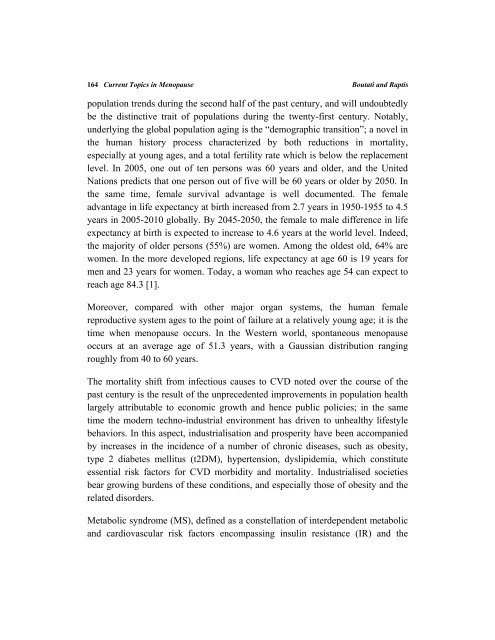Download - Bentham Science
Download - Bentham Science
Download - Bentham Science
You also want an ePaper? Increase the reach of your titles
YUMPU automatically turns print PDFs into web optimized ePapers that Google loves.
164 Current Topics in Menopause Boutati and Raptis<br />
population trends during the second half of the past century, and will undoubtedly<br />
be the distinctive trait of populations during the twenty-first century. Notably,<br />
underlying the global population aging is the “demographic transition”; a novel in<br />
the human history process characterized by both reductions in mortality,<br />
especially at young ages, and a total fertility rate which is below the replacement<br />
level. In 2005, one out of ten persons was 60 years and older, and the United<br />
Nations predicts that one person out of five will be 60 years or older by 2050. In<br />
the same time, female survival advantage is well documented. The female<br />
advantage in life expectancy at birth increased from 2.7 years in 1950-1955 to 4.5<br />
years in 2005-2010 globally. By 2045-2050, the female to male difference in life<br />
expectancy at birth is expected to increase to 4.6 years at the world level. Indeed,<br />
the majority of older persons (55%) are women. Among the oldest old, 64% are<br />
women. In the more developed regions, life expectancy at age 60 is 19 years for<br />
men and 23 years for women. Today, a woman who reaches age 54 can expect to<br />
reach age 84.3 [1].<br />
Moreover, compared with other major organ systems, the human female<br />
reproductive system ages to the point of failure at a relatively young age; it is the<br />
time when menopause occurs. In the Western world, spontaneous menopause<br />
occurs at an average age of 51.3 years, with a Gaussian distribution ranging<br />
roughly from 40 to 60 years.<br />
The mortality shift from infectious causes to CVD noted over the course of the<br />
past century is the result of the unprecedented improvements in population health<br />
largely attributable to economic growth and hence public policies; in the same<br />
time the modern techno-industrial environment has driven to unhealthy lifestyle<br />
behaviors. In this aspect, industrialisation and prosperity have been accompanied<br />
by increases in the incidence of a number of chronic diseases, such as obesity,<br />
type 2 diabetes mellitus (t2DM), hypertension, dyslipidemia, which constitute<br />
essential risk factors for CVD morbidity and mortality. Industrialised societies<br />
bear growing burdens of these conditions, and especially those of obesity and the<br />
related disorders.<br />
Metabolic syndrome (MS), defined as a constellation of interdependent metabolic<br />
and cardiovascular risk factors encompassing insulin resistance (IR) and the
















